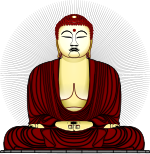Daochuo
| Part of a series on |
| Pure Land Buddhism |
|---|
 |
Daochuo (Chinese: 道綽; pinyin: Dàochuò; Wade–Giles: Tao-ch'o, 562–645), was a Chinese Buddhist scholar of the Mahāyāna Mahāparinirvāṇa Sūtra who later became an eminent scholar of Pure Land Buddhism. In Chinese Buddhist tradition, he is considered the second patriarch of Pure Land Buddhism[1] while In Jōdo Shinshū, he is considered the Fourth Patriarch.
Life and teachings
[edit]Daochuo was born and raised in Bingzhou, Shanxi. According to legend, Daochuo visited the temple of Tan-luan in 609 and read an epitaph on the wall that venerated Tan-luan. Daochuo was so impressed by this inscription that he took up the pursuit of Pure Land Buddhism over his previous studies, including nianfo and daily recitation of the Infinite Life Sutra (Chinese: 無量壽經).[2][1]
Daochuo's main work is the Anle Ji (Chinese: 安樂集, Collected Writings on the Land of Peace and Happiness). This work consists of twelve sections primarily comprising scriptural citations and exhortations encouraging rebirth in Amitābha’s Pure Land of Sukhavati (here called Anleguo).[3]
The Anle Ji introduces a dual classification of the Buddha’s teachings into two “gates” or methods:[3]
- The Gate of the Path of Sages (shengdao men): Focused on teachings that guide practitioners toward achieving nirvāṇa or enlightenment through personal effort.
- The Pure Land Gate (jingtu men): Emphasizes reliance on the chanting of the Buddha’s name (nianfo), particularly that of Amitābha, as a means to attain rebirth in the Pure Land.
This classification became a cornerstone for defending the practice of nianfo within Chinese Buddhism, especially Pure Land Buddhism.[3]
Daochuo also linked the Buddhist concept of the decline of the Dharma with the salvation of Amitābha by teaching that Amitābha's compassion was particularly suited on those living in the current degenerate age.[2]
Some believe that Daochuo's habit of counting his recitations with beans is the origin of Buddhist prayer beads.[1]
References
[edit]- ^ a b c Buswell & Lopez 2013, p. 213.
- ^ a b "Buddhas, bodhisattvas, and teachers, Jodo Shu homepage Homepage". Archived from the original on 2013-08-02. Retrieved 2015-06-30.
- ^ a b c Buswell, Robert E; Lopez, Donald S. The Princeton Dictionary of Buddhism, p. 49. Princeton University Press, Nov 24, 2013.
Bibliography
[edit]- Buswell, Robert; Lopez, Donald S. (2013). The Princeton Dictionary of Buddhism. Princeton University Press. ISBN 978-0-691-15786-3.
External links
[edit]
- 562 births
- 645 deaths
- 6th-century Buddhists
- 7th-century Buddhists
- Chinese spiritual writers
- Jōdo Shin patriarchs
- Northern Zhou Buddhists
- Northern and Southern dynasties Buddhist monks
- People from Lüliang
- Pure Land Buddhists
- Sui dynasty Buddhist monks
- Tang dynasty Buddhist monks
- Tang dynasty writers
- Writers from Shanxi
- Buddhist clergy stubs
- Chinese religious biography stubs
- Mahayana stubs
